Analysis of Leadership Competencies and Project Management Ethics
VerifiedAdded on 2021/02/20
|10
|2887
|32
Report
AI Summary
This report delves into the realm of project management, exploring ethical considerations and leadership competencies. It begins by examining two ethical systems: Right Ethics and Duty Ethics, using a case study of healthcare in Mozambique to illustrate their application. The report then shifts focus to leadership, outlining the 15 leadership competencies suggested by Dulewicz and Higgs, categorizing them into intellectual, managerial, and emotional domains. A key competency, engaging communication, is then analyzed in detail, highlighting its value in project management, including its role in relaying and receiving information, adapting to changing situations, facilitating problem discussions, and bridging language gaps. Finally, the report concludes by discussing the aims of project management leadership, which include anticipating challenges, staying within budget, and ensuring successful project delivery through effective methodologies and tools. This report provides a comprehensive overview of the interplay between ethics, leadership, and communication in achieving successful project outcomes.
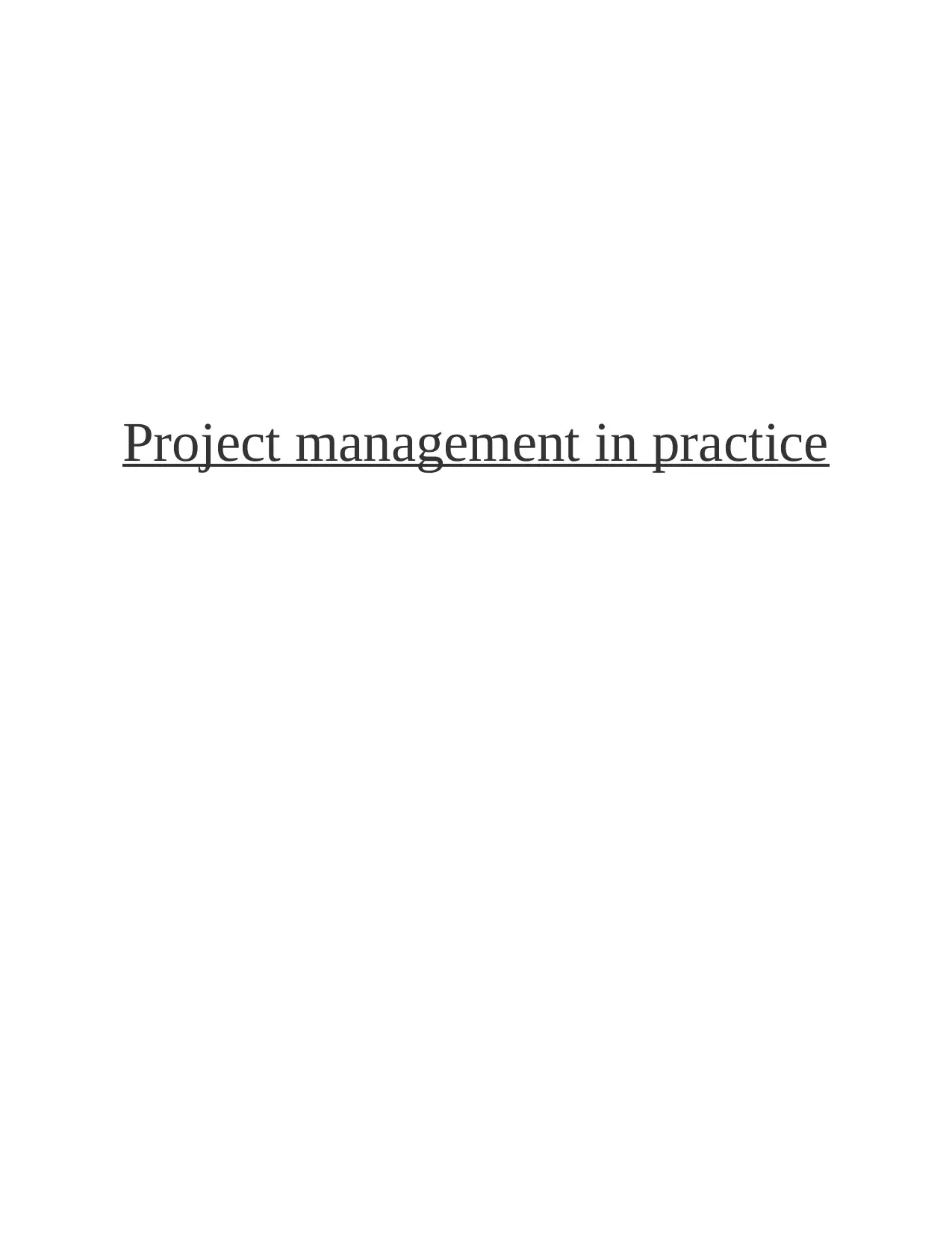
Project management in practice
Paraphrase This Document
Need a fresh take? Get an instant paraphrase of this document with our AI Paraphraser
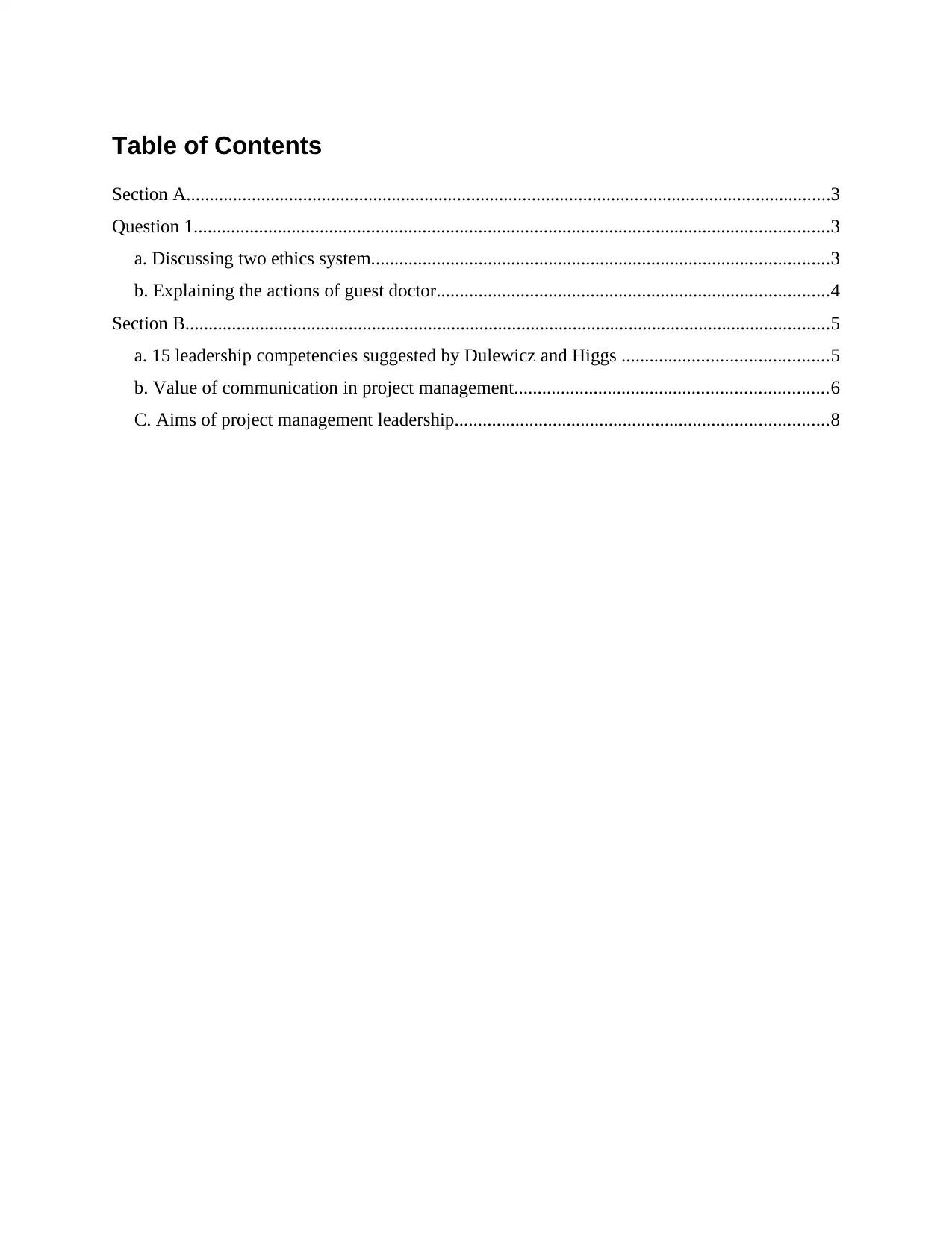
Table of Contents
Section A..........................................................................................................................................3
Question 1........................................................................................................................................3
a. Discussing two ethics system..................................................................................................3
b. Explaining the actions of guest doctor....................................................................................4
Section B..........................................................................................................................................5
a. 15 leadership competencies suggested by Dulewicz and Higgs ............................................5
b. Value of communication in project management...................................................................6
C. Aims of project management leadership................................................................................8
Section A..........................................................................................................................................3
Question 1........................................................................................................................................3
a. Discussing two ethics system..................................................................................................3
b. Explaining the actions of guest doctor....................................................................................4
Section B..........................................................................................................................................5
a. 15 leadership competencies suggested by Dulewicz and Higgs ............................................5
b. Value of communication in project management...................................................................6
C. Aims of project management leadership................................................................................8
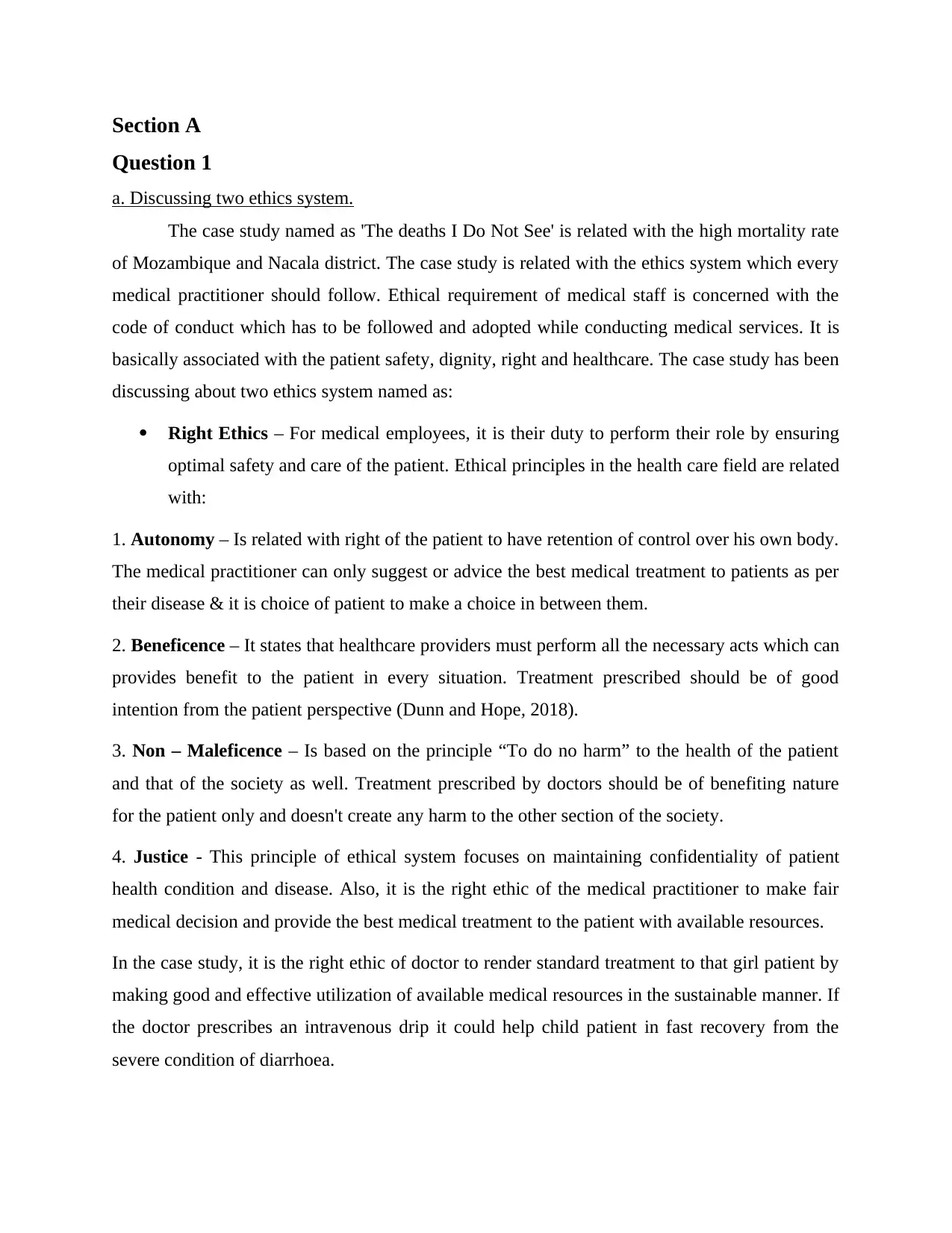
Section A
Question 1
a. Discussing two ethics system.
The case study named as 'The deaths I Do Not See' is related with the high mortality rate
of Mozambique and Nacala district. The case study is related with the ethics system which every
medical practitioner should follow. Ethical requirement of medical staff is concerned with the
code of conduct which has to be followed and adopted while conducting medical services. It is
basically associated with the patient safety, dignity, right and healthcare. The case study has been
discussing about two ethics system named as:
Right Ethics – For medical employees, it is their duty to perform their role by ensuring
optimal safety and care of the patient. Ethical principles in the health care field are related
with:
1. Autonomy – Is related with right of the patient to have retention of control over his own body.
The medical practitioner can only suggest or advice the best medical treatment to patients as per
their disease & it is choice of patient to make a choice in between them.
2. Beneficence – It states that healthcare providers must perform all the necessary acts which can
provides benefit to the patient in every situation. Treatment prescribed should be of good
intention from the patient perspective (Dunn and Hope, 2018).
3. Non – Maleficence – Is based on the principle “To do no harm” to the health of the patient
and that of the society as well. Treatment prescribed by doctors should be of benefiting nature
for the patient only and doesn't create any harm to the other section of the society.
4. Justice - This principle of ethical system focuses on maintaining confidentiality of patient
health condition and disease. Also, it is the right ethic of the medical practitioner to make fair
medical decision and provide the best medical treatment to the patient with available resources.
In the case study, it is the right ethic of doctor to render standard treatment to that girl patient by
making good and effective utilization of available medical resources in the sustainable manner. If
the doctor prescribes an intravenous drip it could help child patient in fast recovery from the
severe condition of diarrhoea.
Question 1
a. Discussing two ethics system.
The case study named as 'The deaths I Do Not See' is related with the high mortality rate
of Mozambique and Nacala district. The case study is related with the ethics system which every
medical practitioner should follow. Ethical requirement of medical staff is concerned with the
code of conduct which has to be followed and adopted while conducting medical services. It is
basically associated with the patient safety, dignity, right and healthcare. The case study has been
discussing about two ethics system named as:
Right Ethics – For medical employees, it is their duty to perform their role by ensuring
optimal safety and care of the patient. Ethical principles in the health care field are related
with:
1. Autonomy – Is related with right of the patient to have retention of control over his own body.
The medical practitioner can only suggest or advice the best medical treatment to patients as per
their disease & it is choice of patient to make a choice in between them.
2. Beneficence – It states that healthcare providers must perform all the necessary acts which can
provides benefit to the patient in every situation. Treatment prescribed should be of good
intention from the patient perspective (Dunn and Hope, 2018).
3. Non – Maleficence – Is based on the principle “To do no harm” to the health of the patient
and that of the society as well. Treatment prescribed by doctors should be of benefiting nature
for the patient only and doesn't create any harm to the other section of the society.
4. Justice - This principle of ethical system focuses on maintaining confidentiality of patient
health condition and disease. Also, it is the right ethic of the medical practitioner to make fair
medical decision and provide the best medical treatment to the patient with available resources.
In the case study, it is the right ethic of doctor to render standard treatment to that girl patient by
making good and effective utilization of available medical resources in the sustainable manner. If
the doctor prescribes an intravenous drip it could help child patient in fast recovery from the
severe condition of diarrhoea.
⊘ This is a preview!⊘
Do you want full access?
Subscribe today to unlock all pages.

Trusted by 1+ million students worldwide
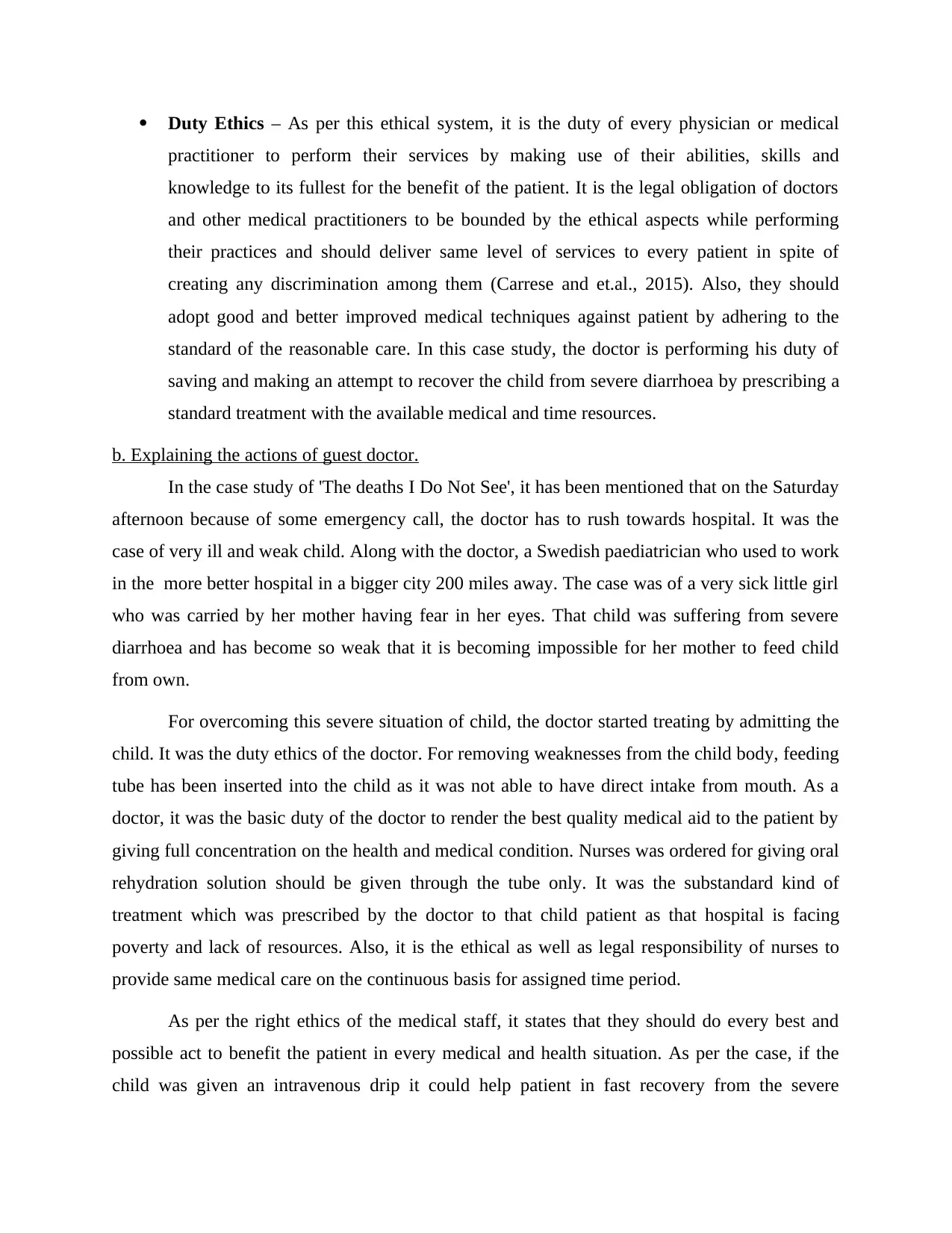
Duty Ethics – As per this ethical system, it is the duty of every physician or medical
practitioner to perform their services by making use of their abilities, skills and
knowledge to its fullest for the benefit of the patient. It is the legal obligation of doctors
and other medical practitioners to be bounded by the ethical aspects while performing
their practices and should deliver same level of services to every patient in spite of
creating any discrimination among them (Carrese and et.al., 2015). Also, they should
adopt good and better improved medical techniques against patient by adhering to the
standard of the reasonable care. In this case study, the doctor is performing his duty of
saving and making an attempt to recover the child from severe diarrhoea by prescribing a
standard treatment with the available medical and time resources.
b. Explaining the actions of guest doctor.
In the case study of 'The deaths I Do Not See', it has been mentioned that on the Saturday
afternoon because of some emergency call, the doctor has to rush towards hospital. It was the
case of very ill and weak child. Along with the doctor, a Swedish paediatrician who used to work
in the more better hospital in a bigger city 200 miles away. The case was of a very sick little girl
who was carried by her mother having fear in her eyes. That child was suffering from severe
diarrhoea and has become so weak that it is becoming impossible for her mother to feed child
from own.
For overcoming this severe situation of child, the doctor started treating by admitting the
child. It was the duty ethics of the doctor. For removing weaknesses from the child body, feeding
tube has been inserted into the child as it was not able to have direct intake from mouth. As a
doctor, it was the basic duty of the doctor to render the best quality medical aid to the patient by
giving full concentration on the health and medical condition. Nurses was ordered for giving oral
rehydration solution should be given through the tube only. It was the substandard kind of
treatment which was prescribed by the doctor to that child patient as that hospital is facing
poverty and lack of resources. Also, it is the ethical as well as legal responsibility of nurses to
provide same medical care on the continuous basis for assigned time period.
As per the right ethics of the medical staff, it states that they should do every best and
possible act to benefit the patient in every medical and health situation. As per the case, if the
child was given an intravenous drip it could help patient in fast recovery from the severe
practitioner to perform their services by making use of their abilities, skills and
knowledge to its fullest for the benefit of the patient. It is the legal obligation of doctors
and other medical practitioners to be bounded by the ethical aspects while performing
their practices and should deliver same level of services to every patient in spite of
creating any discrimination among them (Carrese and et.al., 2015). Also, they should
adopt good and better improved medical techniques against patient by adhering to the
standard of the reasonable care. In this case study, the doctor is performing his duty of
saving and making an attempt to recover the child from severe diarrhoea by prescribing a
standard treatment with the available medical and time resources.
b. Explaining the actions of guest doctor.
In the case study of 'The deaths I Do Not See', it has been mentioned that on the Saturday
afternoon because of some emergency call, the doctor has to rush towards hospital. It was the
case of very ill and weak child. Along with the doctor, a Swedish paediatrician who used to work
in the more better hospital in a bigger city 200 miles away. The case was of a very sick little girl
who was carried by her mother having fear in her eyes. That child was suffering from severe
diarrhoea and has become so weak that it is becoming impossible for her mother to feed child
from own.
For overcoming this severe situation of child, the doctor started treating by admitting the
child. It was the duty ethics of the doctor. For removing weaknesses from the child body, feeding
tube has been inserted into the child as it was not able to have direct intake from mouth. As a
doctor, it was the basic duty of the doctor to render the best quality medical aid to the patient by
giving full concentration on the health and medical condition. Nurses was ordered for giving oral
rehydration solution should be given through the tube only. It was the substandard kind of
treatment which was prescribed by the doctor to that child patient as that hospital is facing
poverty and lack of resources. Also, it is the ethical as well as legal responsibility of nurses to
provide same medical care on the continuous basis for assigned time period.
As per the right ethics of the medical staff, it states that they should do every best and
possible act to benefit the patient in every medical and health situation. As per the case, if the
child was given an intravenous drip it could help patient in fast recovery from the severe
Paraphrase This Document
Need a fresh take? Get an instant paraphrase of this document with our AI Paraphraser
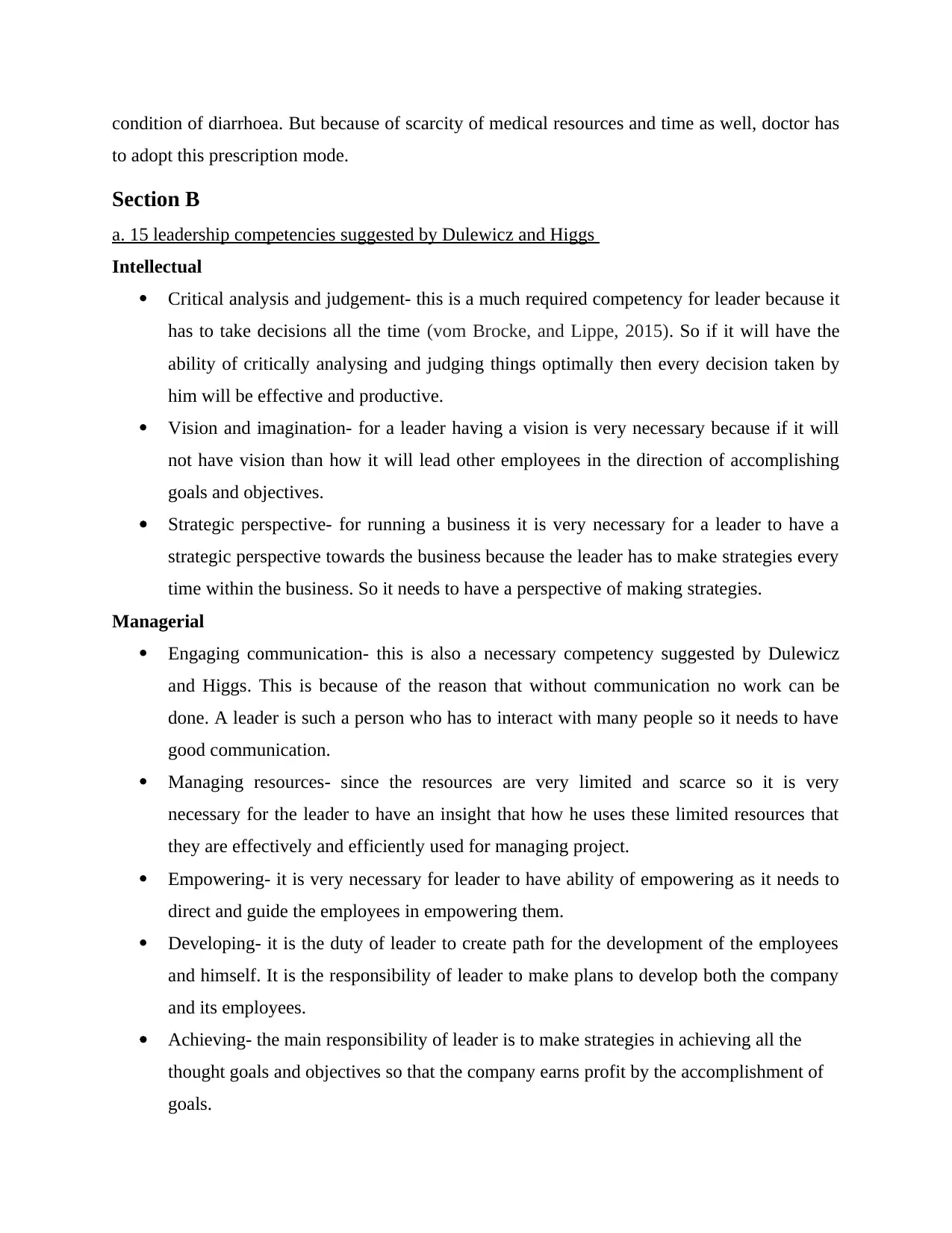
condition of diarrhoea. But because of scarcity of medical resources and time as well, doctor has
to adopt this prescription mode.
Section B
a. 15 leadership competencies suggested by Dulewicz and Higgs
Intellectual
Critical analysis and judgement- this is a much required competency for leader because it
has to take decisions all the time (vom Brocke, and Lippe, 2015). So if it will have the
ability of critically analysing and judging things optimally then every decision taken by
him will be effective and productive.
Vision and imagination- for a leader having a vision is very necessary because if it will
not have vision than how it will lead other employees in the direction of accomplishing
goals and objectives.
Strategic perspective- for running a business it is very necessary for a leader to have a
strategic perspective towards the business because the leader has to make strategies every
time within the business. So it needs to have a perspective of making strategies.
Managerial
Engaging communication- this is also a necessary competency suggested by Dulewicz
and Higgs. This is because of the reason that without communication no work can be
done. A leader is such a person who has to interact with many people so it needs to have
good communication.
Managing resources- since the resources are very limited and scarce so it is very
necessary for the leader to have an insight that how he uses these limited resources that
they are effectively and efficiently used for managing project.
Empowering- it is very necessary for leader to have ability of empowering as it needs to
direct and guide the employees in empowering them.
Developing- it is the duty of leader to create path for the development of the employees
and himself. It is the responsibility of leader to make plans to develop both the company
and its employees.
Achieving- the main responsibility of leader is to make strategies in achieving all the
thought goals and objectives so that the company earns profit by the accomplishment of
goals.
to adopt this prescription mode.
Section B
a. 15 leadership competencies suggested by Dulewicz and Higgs
Intellectual
Critical analysis and judgement- this is a much required competency for leader because it
has to take decisions all the time (vom Brocke, and Lippe, 2015). So if it will have the
ability of critically analysing and judging things optimally then every decision taken by
him will be effective and productive.
Vision and imagination- for a leader having a vision is very necessary because if it will
not have vision than how it will lead other employees in the direction of accomplishing
goals and objectives.
Strategic perspective- for running a business it is very necessary for a leader to have a
strategic perspective towards the business because the leader has to make strategies every
time within the business. So it needs to have a perspective of making strategies.
Managerial
Engaging communication- this is also a necessary competency suggested by Dulewicz
and Higgs. This is because of the reason that without communication no work can be
done. A leader is such a person who has to interact with many people so it needs to have
good communication.
Managing resources- since the resources are very limited and scarce so it is very
necessary for the leader to have an insight that how he uses these limited resources that
they are effectively and efficiently used for managing project.
Empowering- it is very necessary for leader to have ability of empowering as it needs to
direct and guide the employees in empowering them.
Developing- it is the duty of leader to create path for the development of the employees
and himself. It is the responsibility of leader to make plans to develop both the company
and its employees.
Achieving- the main responsibility of leader is to make strategies in achieving all the
thought goals and objectives so that the company earns profit by the accomplishment of
goals.
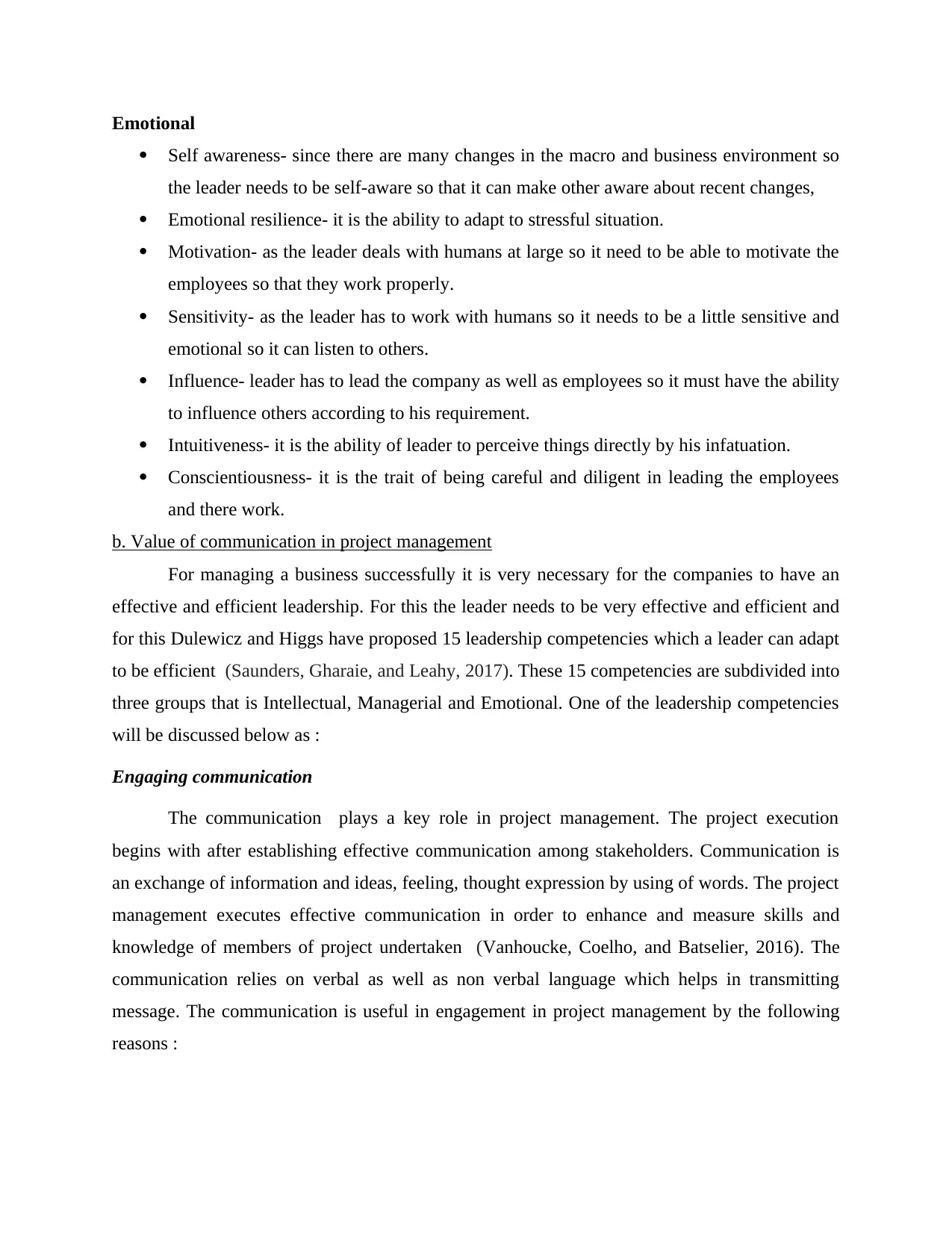
Emotional
Self awareness- since there are many changes in the macro and business environment so
the leader needs to be self-aware so that it can make other aware about recent changes,
Emotional resilience- it is the ability to adapt to stressful situation.
Motivation- as the leader deals with humans at large so it need to be able to motivate the
employees so that they work properly.
Sensitivity- as the leader has to work with humans so it needs to be a little sensitive and
emotional so it can listen to others.
Influence- leader has to lead the company as well as employees so it must have the ability
to influence others according to his requirement.
Intuitiveness- it is the ability of leader to perceive things directly by his infatuation.
Conscientiousness- it is the trait of being careful and diligent in leading the employees
and there work.
b. Value of communication in project management
For managing a business successfully it is very necessary for the companies to have an
effective and efficient leadership. For this the leader needs to be very effective and efficient and
for this Dulewicz and Higgs have proposed 15 leadership competencies which a leader can adapt
to be efficient (Saunders, Gharaie, and Leahy, 2017). These 15 competencies are subdivided into
three groups that is Intellectual, Managerial and Emotional. One of the leadership competencies
will be discussed below as :
Engaging communication
The communication plays a key role in project management. The project execution
begins with after establishing effective communication among stakeholders. Communication is
an exchange of information and ideas, feeling, thought expression by using of words. The project
management executes effective communication in order to enhance and measure skills and
knowledge of members of project undertaken (Vanhoucke, Coelho, and Batselier, 2016). The
communication relies on verbal as well as non verbal language which helps in transmitting
message. The communication is useful in engagement in project management by the following
reasons :
Self awareness- since there are many changes in the macro and business environment so
the leader needs to be self-aware so that it can make other aware about recent changes,
Emotional resilience- it is the ability to adapt to stressful situation.
Motivation- as the leader deals with humans at large so it need to be able to motivate the
employees so that they work properly.
Sensitivity- as the leader has to work with humans so it needs to be a little sensitive and
emotional so it can listen to others.
Influence- leader has to lead the company as well as employees so it must have the ability
to influence others according to his requirement.
Intuitiveness- it is the ability of leader to perceive things directly by his infatuation.
Conscientiousness- it is the trait of being careful and diligent in leading the employees
and there work.
b. Value of communication in project management
For managing a business successfully it is very necessary for the companies to have an
effective and efficient leadership. For this the leader needs to be very effective and efficient and
for this Dulewicz and Higgs have proposed 15 leadership competencies which a leader can adapt
to be efficient (Saunders, Gharaie, and Leahy, 2017). These 15 competencies are subdivided into
three groups that is Intellectual, Managerial and Emotional. One of the leadership competencies
will be discussed below as :
Engaging communication
The communication plays a key role in project management. The project execution
begins with after establishing effective communication among stakeholders. Communication is
an exchange of information and ideas, feeling, thought expression by using of words. The project
management executes effective communication in order to enhance and measure skills and
knowledge of members of project undertaken (Vanhoucke, Coelho, and Batselier, 2016). The
communication relies on verbal as well as non verbal language which helps in transmitting
message. The communication is useful in engagement in project management by the following
reasons :
⊘ This is a preview!⊘
Do you want full access?
Subscribe today to unlock all pages.

Trusted by 1+ million students worldwide
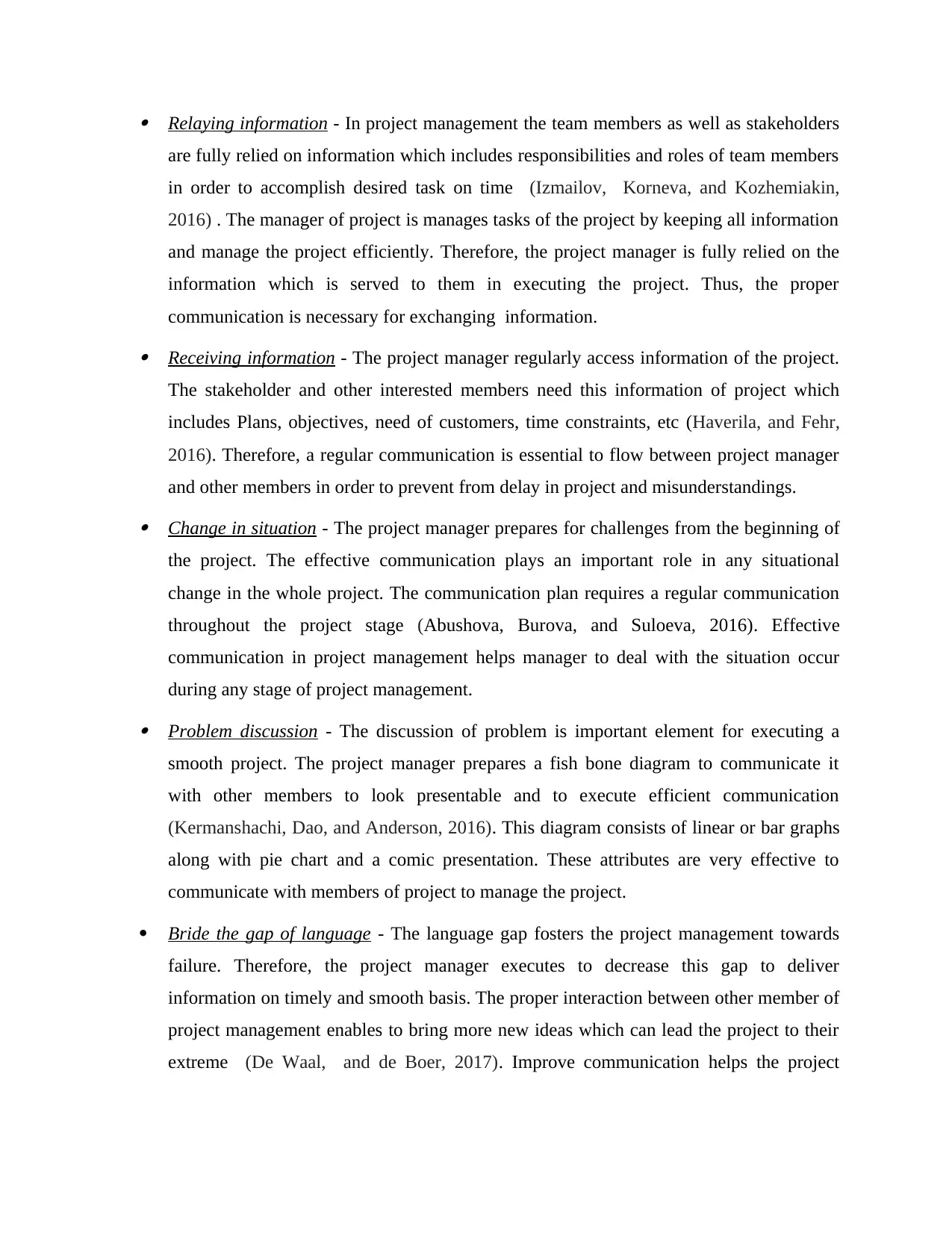
Relaying information - In project management the team members as well as stakeholders
are fully relied on information which includes responsibilities and roles of team members
in order to accomplish desired task on time (Izmailov, Korneva, and Kozhemiakin,
2016) . The manager of project is manages tasks of the project by keeping all information
and manage the project efficiently. Therefore, the project manager is fully relied on the
information which is served to them in executing the project. Thus, the proper
communication is necessary for exchanging information. Receiving information - The project manager regularly access information of the project.
The stakeholder and other interested members need this information of project which
includes Plans, objectives, need of customers, time constraints, etc (Haverila, and Fehr,
2016). Therefore, a regular communication is essential to flow between project manager
and other members in order to prevent from delay in project and misunderstandings. Change in situation - The project manager prepares for challenges from the beginning of
the project. The effective communication plays an important role in any situational
change in the whole project. The communication plan requires a regular communication
throughout the project stage (Abushova, Burova, and Suloeva, 2016). Effective
communication in project management helps manager to deal with the situation occur
during any stage of project management. Problem discussion - The discussion of problem is important element for executing a
smooth project. The project manager prepares a fish bone diagram to communicate it
with other members to look presentable and to execute efficient communication
(Kermanshachi, Dao, and Anderson, 2016). This diagram consists of linear or bar graphs
along with pie chart and a comic presentation. These attributes are very effective to
communicate with members of project to manage the project.
Bride the gap of language - The language gap fosters the project management towards
failure. Therefore, the project manager executes to decrease this gap to deliver
information on timely and smooth basis. The proper interaction between other member of
project management enables to bring more new ideas which can lead the project to their
extreme (De Waal, and de Boer, 2017). Improve communication helps the project
are fully relied on information which includes responsibilities and roles of team members
in order to accomplish desired task on time (Izmailov, Korneva, and Kozhemiakin,
2016) . The manager of project is manages tasks of the project by keeping all information
and manage the project efficiently. Therefore, the project manager is fully relied on the
information which is served to them in executing the project. Thus, the proper
communication is necessary for exchanging information. Receiving information - The project manager regularly access information of the project.
The stakeholder and other interested members need this information of project which
includes Plans, objectives, need of customers, time constraints, etc (Haverila, and Fehr,
2016). Therefore, a regular communication is essential to flow between project manager
and other members in order to prevent from delay in project and misunderstandings. Change in situation - The project manager prepares for challenges from the beginning of
the project. The effective communication plays an important role in any situational
change in the whole project. The communication plan requires a regular communication
throughout the project stage (Abushova, Burova, and Suloeva, 2016). Effective
communication in project management helps manager to deal with the situation occur
during any stage of project management. Problem discussion - The discussion of problem is important element for executing a
smooth project. The project manager prepares a fish bone diagram to communicate it
with other members to look presentable and to execute efficient communication
(Kermanshachi, Dao, and Anderson, 2016). This diagram consists of linear or bar graphs
along with pie chart and a comic presentation. These attributes are very effective to
communicate with members of project to manage the project.
Bride the gap of language - The language gap fosters the project management towards
failure. Therefore, the project manager executes to decrease this gap to deliver
information on timely and smooth basis. The proper interaction between other member of
project management enables to bring more new ideas which can lead the project to their
extreme (De Waal, and de Boer, 2017). Improve communication helps the project
Paraphrase This Document
Need a fresh take? Get an instant paraphrase of this document with our AI Paraphraser
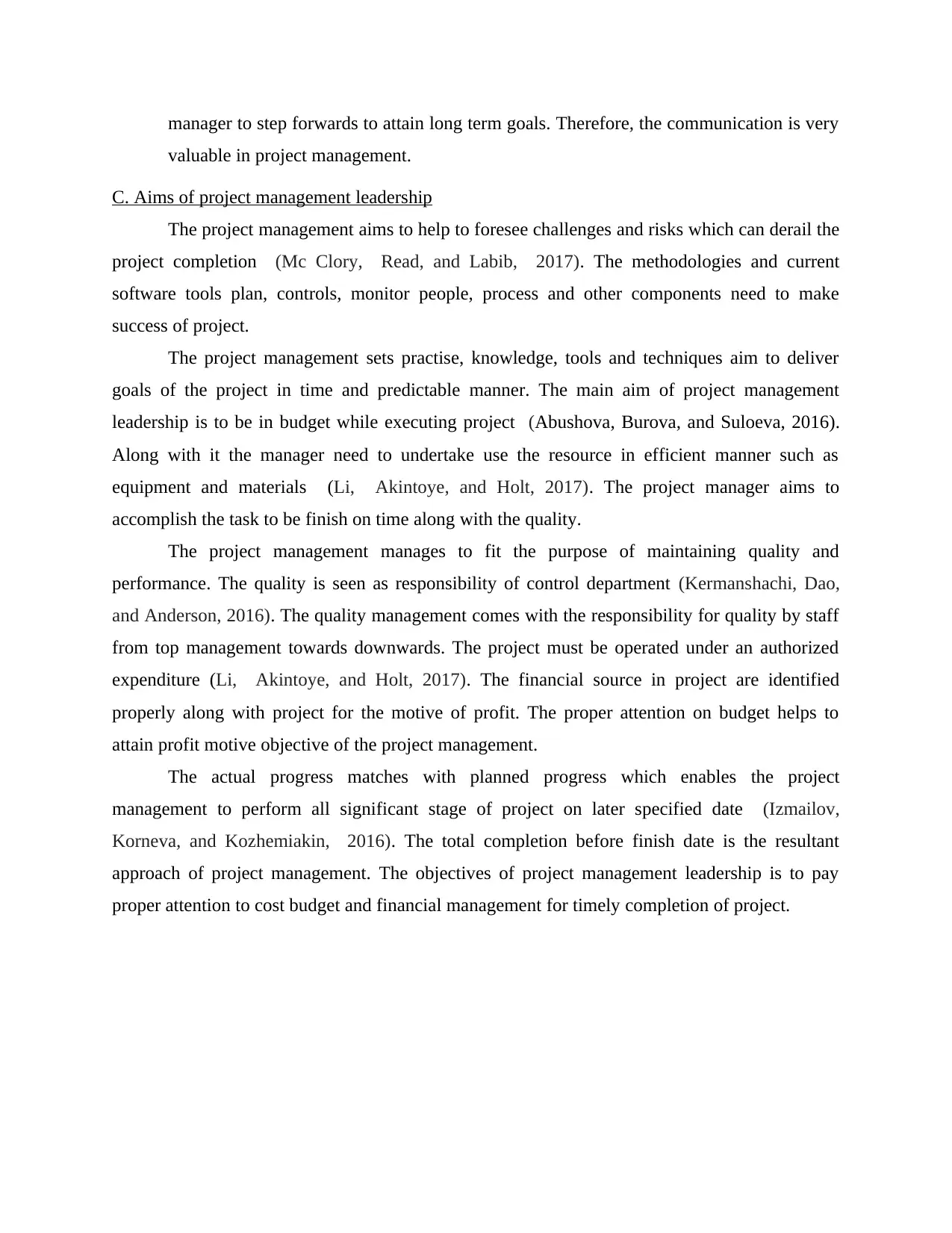
manager to step forwards to attain long term goals. Therefore, the communication is very
valuable in project management.
C. Aims of project management leadership
The project management aims to help to foresee challenges and risks which can derail the
project completion (Mc Clory, Read, and Labib, 2017). The methodologies and current
software tools plan, controls, monitor people, process and other components need to make
success of project.
The project management sets practise, knowledge, tools and techniques aim to deliver
goals of the project in time and predictable manner. The main aim of project management
leadership is to be in budget while executing project (Abushova, Burova, and Suloeva, 2016).
Along with it the manager need to undertake use the resource in efficient manner such as
equipment and materials (Li, Akintoye, and Holt, 2017). The project manager aims to
accomplish the task to be finish on time along with the quality.
The project management manages to fit the purpose of maintaining quality and
performance. The quality is seen as responsibility of control department (Kermanshachi, Dao,
and Anderson, 2016). The quality management comes with the responsibility for quality by staff
from top management towards downwards. The project must be operated under an authorized
expenditure (Li, Akintoye, and Holt, 2017). The financial source in project are identified
properly along with project for the motive of profit. The proper attention on budget helps to
attain profit motive objective of the project management.
The actual progress matches with planned progress which enables the project
management to perform all significant stage of project on later specified date (Izmailov,
Korneva, and Kozhemiakin, 2016). The total completion before finish date is the resultant
approach of project management. The objectives of project management leadership is to pay
proper attention to cost budget and financial management for timely completion of project.
valuable in project management.
C. Aims of project management leadership
The project management aims to help to foresee challenges and risks which can derail the
project completion (Mc Clory, Read, and Labib, 2017). The methodologies and current
software tools plan, controls, monitor people, process and other components need to make
success of project.
The project management sets practise, knowledge, tools and techniques aim to deliver
goals of the project in time and predictable manner. The main aim of project management
leadership is to be in budget while executing project (Abushova, Burova, and Suloeva, 2016).
Along with it the manager need to undertake use the resource in efficient manner such as
equipment and materials (Li, Akintoye, and Holt, 2017). The project manager aims to
accomplish the task to be finish on time along with the quality.
The project management manages to fit the purpose of maintaining quality and
performance. The quality is seen as responsibility of control department (Kermanshachi, Dao,
and Anderson, 2016). The quality management comes with the responsibility for quality by staff
from top management towards downwards. The project must be operated under an authorized
expenditure (Li, Akintoye, and Holt, 2017). The financial source in project are identified
properly along with project for the motive of profit. The proper attention on budget helps to
attain profit motive objective of the project management.
The actual progress matches with planned progress which enables the project
management to perform all significant stage of project on later specified date (Izmailov,
Korneva, and Kozhemiakin, 2016). The total completion before finish date is the resultant
approach of project management. The objectives of project management leadership is to pay
proper attention to cost budget and financial management for timely completion of project.
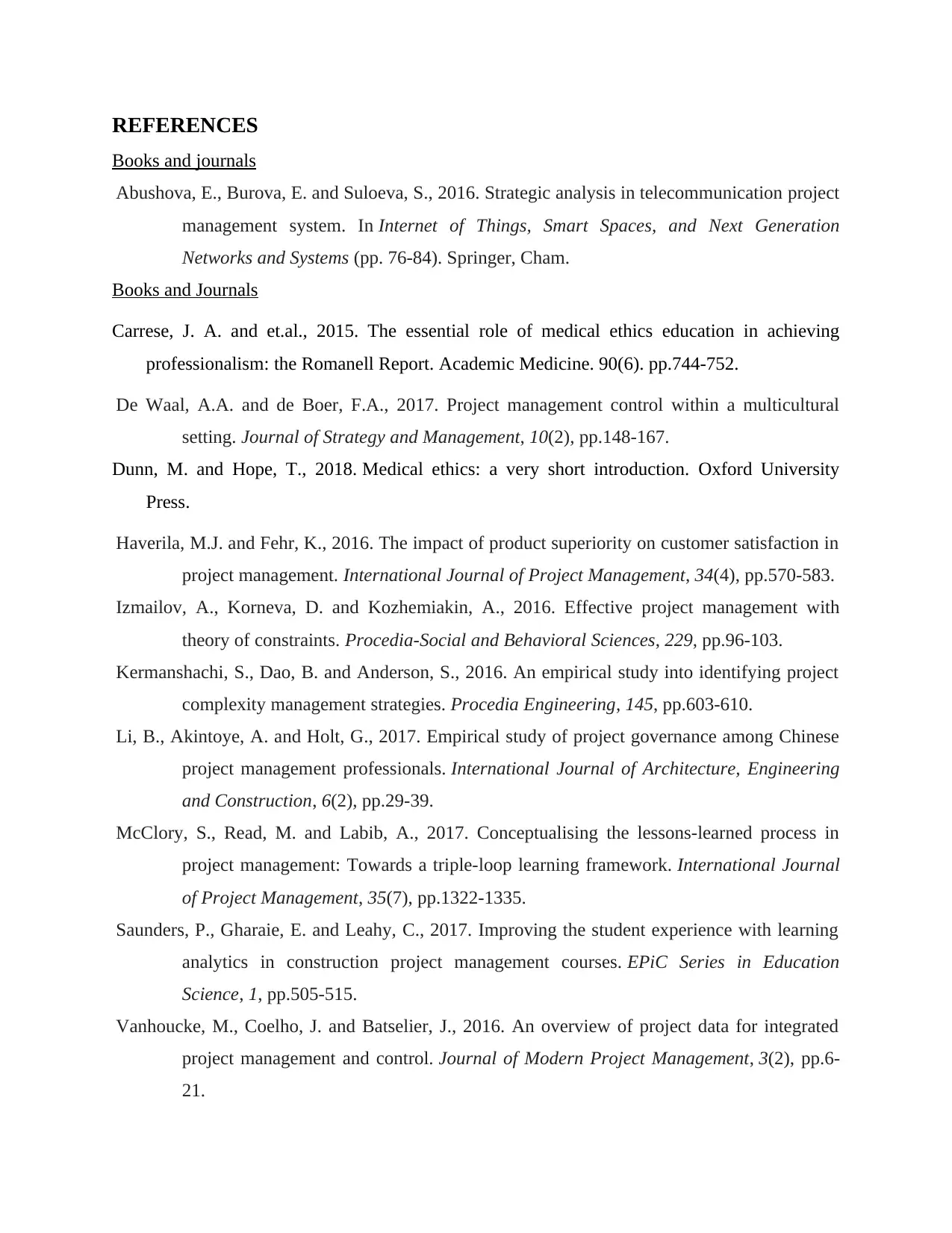
REFERENCES
Books and journals
Abushova, E., Burova, E. and Suloeva, S., 2016. Strategic analysis in telecommunication project
management system. In Internet of Things, Smart Spaces, and Next Generation
Networks and Systems (pp. 76-84). Springer, Cham.
Books and Journals
Carrese, J. A. and et.al., 2015. The essential role of medical ethics education in achieving
professionalism: the Romanell Report. Academic Medicine. 90(6). pp.744-752.
De Waal, A.A. and de Boer, F.A., 2017. Project management control within a multicultural
setting. Journal of Strategy and Management, 10(2), pp.148-167.
Dunn, M. and Hope, T., 2018. Medical ethics: a very short introduction. Oxford University
Press.
Haverila, M.J. and Fehr, K., 2016. The impact of product superiority on customer satisfaction in
project management. International Journal of Project Management, 34(4), pp.570-583.
Izmailov, A., Korneva, D. and Kozhemiakin, A., 2016. Effective project management with
theory of constraints. Procedia-Social and Behavioral Sciences, 229, pp.96-103.
Kermanshachi, S., Dao, B. and Anderson, S., 2016. An empirical study into identifying project
complexity management strategies. Procedia Engineering, 145, pp.603-610.
Li, B., Akintoye, A. and Holt, G., 2017. Empirical study of project governance among Chinese
project management professionals. International Journal of Architecture, Engineering
and Construction, 6(2), pp.29-39.
McClory, S., Read, M. and Labib, A., 2017. Conceptualising the lessons-learned process in
project management: Towards a triple-loop learning framework. International Journal
of Project Management, 35(7), pp.1322-1335.
Saunders, P., Gharaie, E. and Leahy, C., 2017. Improving the student experience with learning
analytics in construction project management courses. EPiC Series in Education
Science, 1, pp.505-515.
Vanhoucke, M., Coelho, J. and Batselier, J., 2016. An overview of project data for integrated
project management and control. Journal of Modern Project Management, 3(2), pp.6-
21.
Books and journals
Abushova, E., Burova, E. and Suloeva, S., 2016. Strategic analysis in telecommunication project
management system. In Internet of Things, Smart Spaces, and Next Generation
Networks and Systems (pp. 76-84). Springer, Cham.
Books and Journals
Carrese, J. A. and et.al., 2015. The essential role of medical ethics education in achieving
professionalism: the Romanell Report. Academic Medicine. 90(6). pp.744-752.
De Waal, A.A. and de Boer, F.A., 2017. Project management control within a multicultural
setting. Journal of Strategy and Management, 10(2), pp.148-167.
Dunn, M. and Hope, T., 2018. Medical ethics: a very short introduction. Oxford University
Press.
Haverila, M.J. and Fehr, K., 2016. The impact of product superiority on customer satisfaction in
project management. International Journal of Project Management, 34(4), pp.570-583.
Izmailov, A., Korneva, D. and Kozhemiakin, A., 2016. Effective project management with
theory of constraints. Procedia-Social and Behavioral Sciences, 229, pp.96-103.
Kermanshachi, S., Dao, B. and Anderson, S., 2016. An empirical study into identifying project
complexity management strategies. Procedia Engineering, 145, pp.603-610.
Li, B., Akintoye, A. and Holt, G., 2017. Empirical study of project governance among Chinese
project management professionals. International Journal of Architecture, Engineering
and Construction, 6(2), pp.29-39.
McClory, S., Read, M. and Labib, A., 2017. Conceptualising the lessons-learned process in
project management: Towards a triple-loop learning framework. International Journal
of Project Management, 35(7), pp.1322-1335.
Saunders, P., Gharaie, E. and Leahy, C., 2017. Improving the student experience with learning
analytics in construction project management courses. EPiC Series in Education
Science, 1, pp.505-515.
Vanhoucke, M., Coelho, J. and Batselier, J., 2016. An overview of project data for integrated
project management and control. Journal of Modern Project Management, 3(2), pp.6-
21.
⊘ This is a preview!⊘
Do you want full access?
Subscribe today to unlock all pages.

Trusted by 1+ million students worldwide
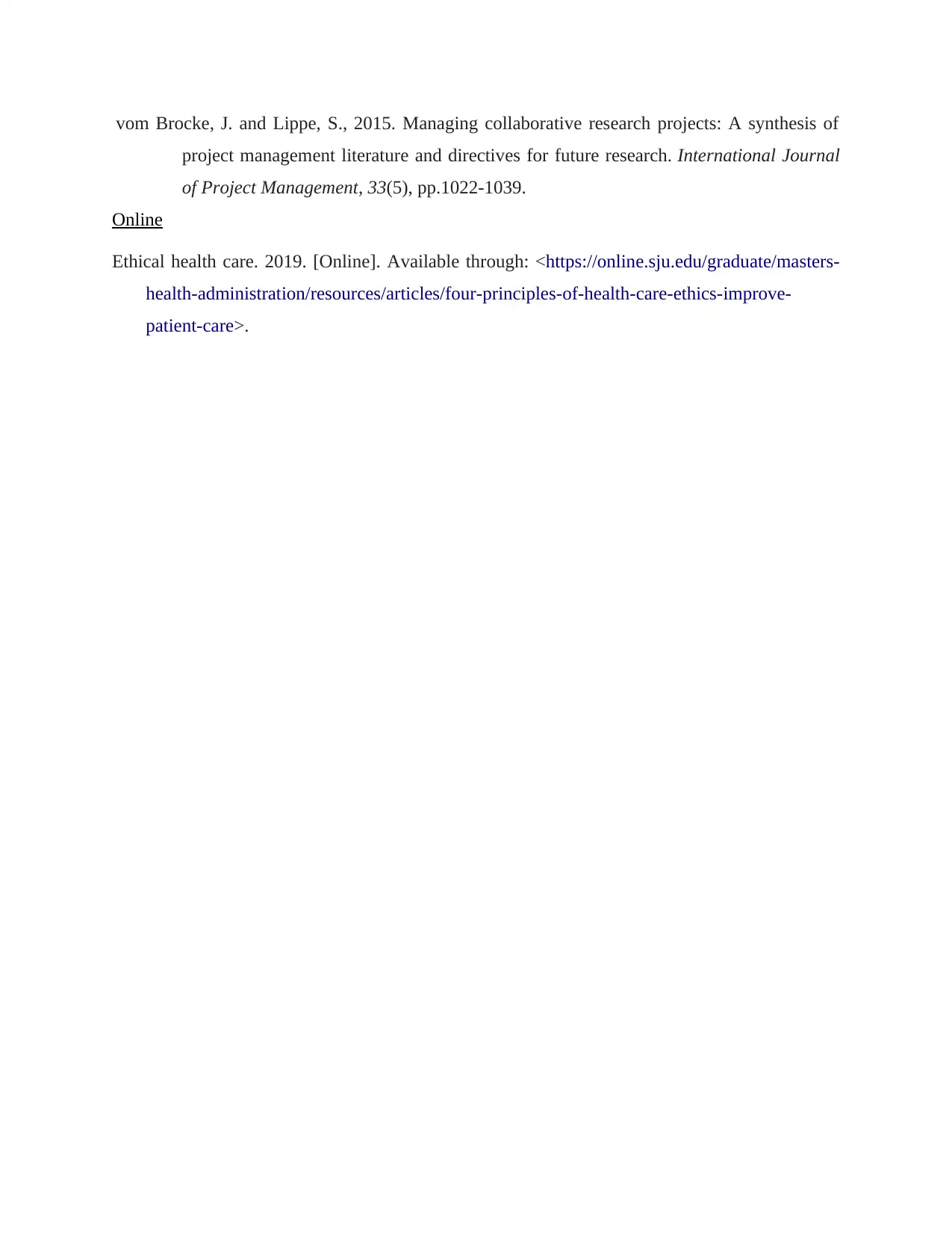
vom Brocke, J. and Lippe, S., 2015. Managing collaborative research projects: A synthesis of
project management literature and directives for future research. International Journal
of Project Management, 33(5), pp.1022-1039.
Online
Ethical health care. 2019. [Online]. Available through: <https://online.sju.edu/graduate/masters-
health-administration/resources/articles/four-principles-of-health-care-ethics-improve-
patient-care>.
project management literature and directives for future research. International Journal
of Project Management, 33(5), pp.1022-1039.
Online
Ethical health care. 2019. [Online]. Available through: <https://online.sju.edu/graduate/masters-
health-administration/resources/articles/four-principles-of-health-care-ethics-improve-
patient-care>.
1 out of 10
Related Documents
Your All-in-One AI-Powered Toolkit for Academic Success.
+13062052269
info@desklib.com
Available 24*7 on WhatsApp / Email
![[object Object]](/_next/static/media/star-bottom.7253800d.svg)
Unlock your academic potential
Copyright © 2020–2025 A2Z Services. All Rights Reserved. Developed and managed by ZUCOL.





